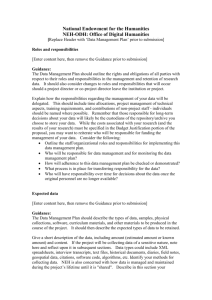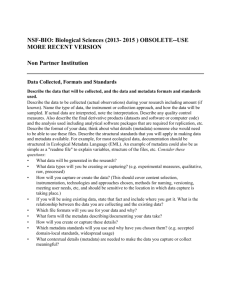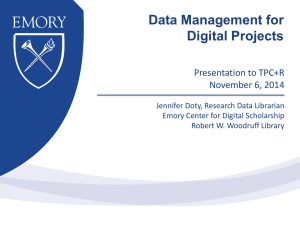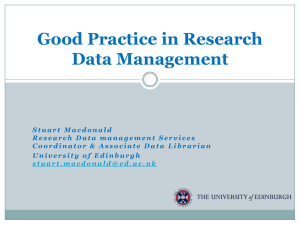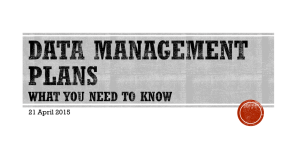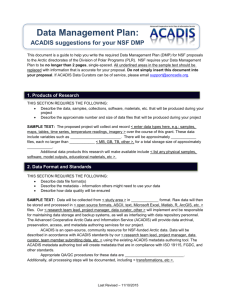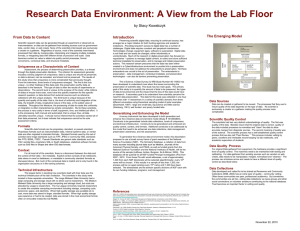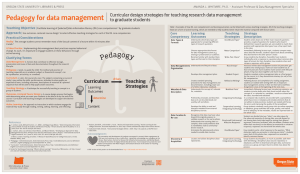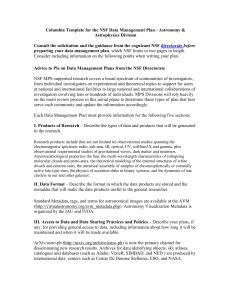NEH-ODH: Office of Digital Humanities
advertisement
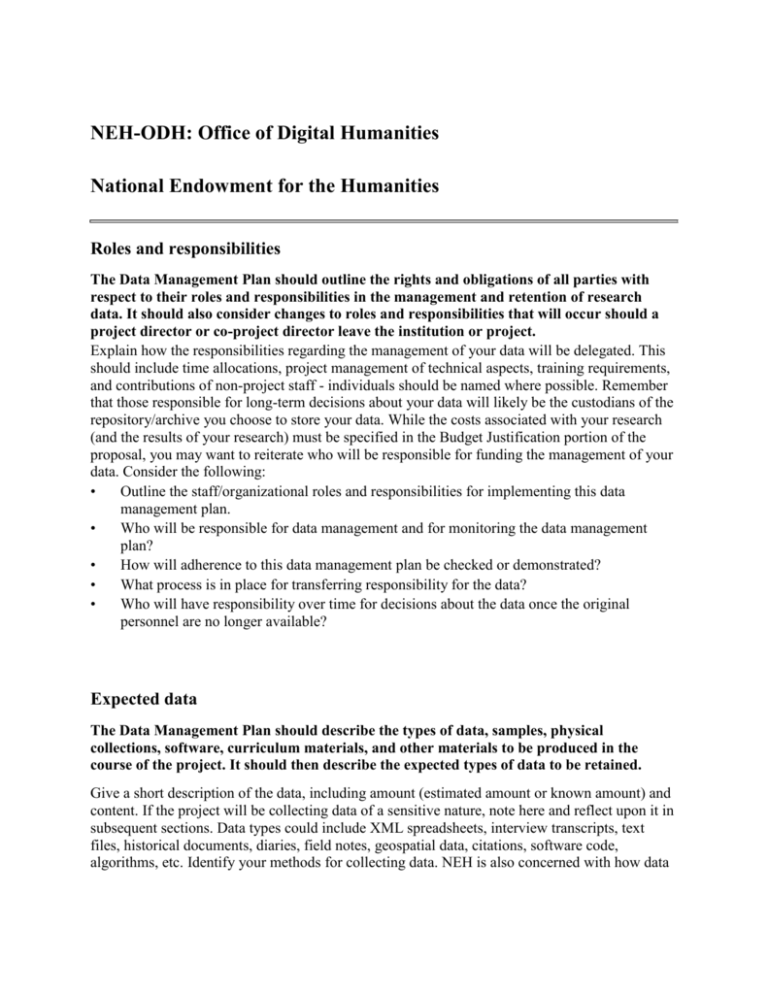
NEH-ODH: Office of Digital Humanities National Endowment for the Humanities Roles and responsibilities The Data Management Plan should outline the rights and obligations of all parties with respect to their roles and responsibilities in the management and retention of research data. It should also consider changes to roles and responsibilities that will occur should a project director or co-project director leave the institution or project. Explain how the responsibilities regarding the management of your data will be delegated. This should include time allocations, project management of technical aspects, training requirements, and contributions of non-project staff - individuals should be named where possible. Remember that those responsible for long-term decisions about your data will likely be the custodians of the repository/archive you choose to store your data. While the costs associated with your research (and the results of your research) must be specified in the Budget Justification portion of the proposal, you may want to reiterate who will be responsible for funding the management of your data. Consider the following: • Outline the staff/organizational roles and responsibilities for implementing this data management plan. • Who will be responsible for data management and for monitoring the data management plan? • How will adherence to this data management plan be checked or demonstrated? • What process is in place for transferring responsibility for the data? • Who will have responsibility over time for decisions about the data once the original personnel are no longer available? Expected data The Data Management Plan should describe the types of data, samples, physical collections, software, curriculum materials, and other materials to be produced in the course of the project. It should then describe the expected types of data to be retained. Give a short description of the data, including amount (estimated amount or known amount) and content. If the project will be collecting data of a sensitive nature, note here and reflect upon it in subsequent sections. Data types could include XML spreadsheets, interview transcripts, text files, historical documents, diaries, field notes, geospatial data, citations, software code, algorithms, etc. Identify your methods for collecting data. NEH is also concerned with how data is managed and maintained during the project’s lifetime until it is "shared". Describe in this section your short-term (project's lifetime) data management plan. Consider these questions: • • • • • • • What data will be generated in the research? What data types will you be creating or capturing? How will you capture or create the data? If you will be using existing data, state that fact and include where you got it. What is the relationship between the data you are collecting and the existing data? What data will be preserved and shared? Where (physically) and on what media will you store the data during the project’s lifetime? How will you back-up the data during the project's lifetime and how regularly will back-ups be made? Period of data retention NEH is committed to timely and rapid data distribution. However, it recognizes that types of data can vary widely and that acceptable norms also vary by discipline. It is strongly committed, however, to the underlying principle of timely access. In their DMP applicants should address how timely access will be assured. Explain the policies that may restrict the distribution of your data, and describe how you will make sure that access to data is made available in a timely manner. Consider these questions: • • How long will the original data collector/creator/principal investigator retain the right to use the data before opening it up to wider use? Explain details of any embargo periods for political, commercial, patent or publisher reasons. Data formats and dissemination The Data Management Plan should describe data formats, media, and dissemination approaches that will be used to make data and metadata available to others. Policies for public access and sharing should be described, including provisions for appropriate protection of privacy, confidentiality, security, intellectual property, or other rights or requirements. Research centers and major partnerships with industry or other user communities must also address how data are to be shared and managed with partners, center members, and other major stakeholders. Describe the format of your data. Ideally, data formats will be chosen that are openly and freely available, and/or non-proprietary in nature. Consider the following: • Which file formats will you use for your data, and why? • What transformations (to more shareable formats) will be necessary to prepare data for preservation and data sharing? • • • What form will the metadata take? How will you create or capture these details? Which metadata standards will you use and why have you chosen them? (e.g. accepted domain-local standards, widespread usage). • What contextual details (metadata) are needed to make the data you capture or collect meaningful? Describe how you will ensure dissemination of your data. Consider the following: • How and when will you make the data available? (Include the resources needed to make the data available: equipment, systems, expertise, etc.) • What other types of information should be shared regarding the data, e.g. the way it was generated, analytical and procedural, information? • What is the process for gaining access to the data? • Will any permission restrictions need to be placed on the data? • How will you manage data with sensitive information? • Are there ethical and privacy issues? If so, how will these be resolved? • What have you done to comply with your obligations in your IRB Protocol? Data storage and preservation of access The Data Management Plan should describe physical and cyber resources and facilities that will be used for the effective preservation and storage of research data. These can include third party facilities and repositories." Describe your long-term strategy for storing, archiving and preserving the data you will generate or use. Consider the following: • What is the long-term strategy for maintaining, curating and archiving the data? • Which archive/repository/database have you identified as a place to deposit data? • What procedures does your intended long-term data storage facility have in place for preservation and backup? • How long will/should data be kept beyond the life of the project? • What data will be preserved for the long-term? • On what basis will data be selected for long-term preservation? • What metadata/documentation will be submitted alongside the data or created on deposit/transformation in order to make the data reusable? • What related information will be deposited?
